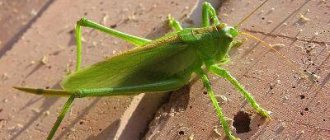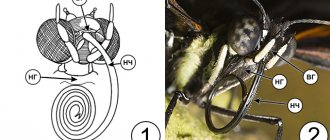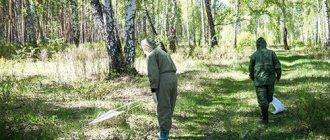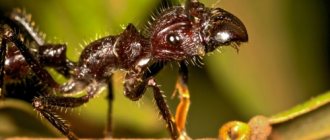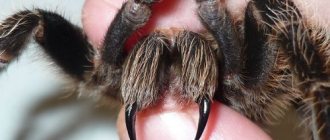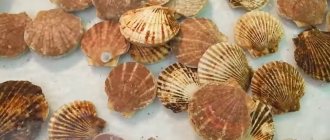Locusts have long been called the scourge of God and were believed to be sent as punishment for human sins. Since ancient times, entire countries have suffered from the invasion of this armada.
One individual eats an amount of plant food per day equal to its weight, and a flock of a million individuals is capable of leaving an area of several thousand square kilometers without any vegetation.
Description and appearance
The true locust family includes more than 10 thousand species. In the territory of the former USSR alone, there are about 100 genera of locusts.
The locust is still a completely separate representative of the order of Orthoptera insects, although it is similar to grasshoppers and crickets. Their relatedness is emphasized by their similar structure. She has an oblong body, six limbs, of which the front ones are noticeably shorter and weaker. The hind legs are hopping and much longer than the rest. The elytra are narrow and opaque. But the wings themselves, when well developed, are wide and thin. In some species they are brightly colored and may have spots and stripes.
Appearance
The size of locusts depends on the species. Most often, adults grow up to 1–6 cm. Individual representatives of large varieties reach 10–15 cm.
The head has an oval or triangular shape. Compounded eyes can distinguish not only moving, but also static objects, their color, and determine the distance to them. Short antennae are organs of smell and touch. The gnawing type mouthparts are designed for eating rough plant foods.
The color of a locust depends on several factors. This includes the species, the area where it lives, and what it eats. Singles, as a rule, have protective colors that help them mimic their environment. In a flock, all insects acquire a similar shade of cover.
How to recognize locusts
Some types of locusts are very similar to grasshoppers. However, there are a number of differences that will help you recognize the insect:
- unlike the grasshopper, the locust has wings;
- the length of the legs and antennae of the locust is less than that of the grasshopper;
- Locust activity occurs during the day, and grasshopper activity occurs at night.
Grasshoppers are predators by nature, but they do not harm crops. Locusts, on the contrary, eat grain crops, and only occasionally a weaker individual from the swarm to obtain liquid.
Kinds
The pest is found on all continents except Antarctica. The most dangerous types of locusts for agricultural activities are:
- Migratory (Asian). Insects grow up to 5–6 cm. Adults are green, tan or gray in color. They feed on vegetables, berries and industrial crops. In a flock it can migrate up to 300 km.
- Moroccan. It is this type of locust that is described in the Bible as one of the plagues of Egypt. The body is reddish or grayish-cinnamon in color with chaotic spots. On the back there is a pattern in the form of a cross in a lighter color. The tips of the legs are red. The diet of insects includes cereals, melons, and cotton. It gathers in flocks of millions, sometimes exceeding 200 km in length. Destroys vegetation in its path, gnawing stems close to the ground.
- Siberian filly. The color of locusts ranges from brown to green. It is a pest of grain crops, garden crops, pastures and hayfields. The species is resistant to temperature changes. Death occurs at -10°C. Adults prefer to lead a solitary lifestyle.
- Desert (African) lives in arid areas, so it is not particularly picky in choosing food. Its diet includes about 500 species of various plants, including tree species. Young individuals have a pinkish tint, and as they age, the locusts acquire a lemon color and begin to look the same as the surrounding sun-scorched landscape. Flocking together in flocks, they can fly up to 100 km in search of food.
Egyptian execution: locusts have occupied Asia and Africa and perhaps this is forever
What other locusts?
At the end of February 2021, the UN warned of increased numbers of desert locusts spreading across East Africa and South Asia.
This invasion is the largest in the last 25 years. The insects have already destroyed crops in Somalia, Ethiopia and Kenya, countries that are particularly dependent on agriculture. The problem is not limited to Africa: swarms of locusts are also found in Saudi Arabia and Pakistan.
Remember when I posted a report about the plague of locusts devastating east Africa? We support a pastor in Kenya who sent this video. He says all vegetation is gone, farming is destroyed, and I imagine a famine is on the way. Please pray for Kenya. #Kenya #Locusts pic.twitter.com/g3LrGd7P3H
— VM Swiderski (@VMSwiderski) March 4, 2020
How do flocks arise?
The desert or African locust is a species of short-horned grasshopper in the family Acrididae. Usually they live alone and cause little damage to humans, but when the environment is favorable for them for a long time (often this happens after heavy rains or cyclones), but there is not enough food, they gather in huge colonies. As they become more numerous, insects change their behavior to group behavior. Their color and size change - from brown to pink.
Desert Locust
The problem is that desert locusts typically live in dry areas in about 30 countries located between West Africa and India. The area of its habitat is approximately 16 million square meters. km, and a small number of people live near this territory. Therefore, the first swarms of locusts are difficult to detect quickly.
A plague of locusts is expected to hit Africa in the coming days as #locusts breed at alarming rates#LocustInvasion #LocustPlague https://t.co/IwkTy0t6mw pic.twitter.com/730fwxVUR9
— Daily Express (@Daily_Express) February 25, 2020
The reasons for the current spread are related to the rains of 2018-2019. Wet and favorable conditions in the southern Arabian Peninsula have allowed three generations of locusts to spread undetected, the UN says. By early 2021, the first flocks headed to Yemen, Saudi Arabia and Iran, further breeding, and then moved to East Africa. Further flocks formed in Eritrea, Djibouti and Kenya.
How big are these flocks and what are the dangers?
Researchers in Kenya reported the largest swarms, which included 200 billion insects; such a swarm could eat enough food in a day to feed 84 million people. They can travel up to 150 km per day and lay eggs. Accordingly, the number of locusts is only increasing; the UN believes that their numbers could increase 500 times.
Locust infestation in Bahrain… pic.twitter.com/5JmTVZw7q3
— Girish Govindankutty® (@GirishGNair) February 20, 2020
The authorities of countries affected by the threat of catastrophic reproduction of these insects fear that locust raids could lead to a decline in agriculture, which will later cause famine (these countries have previously suffered from floods and droughts). According to the UN, more than 20 million people could be affected.
And for those who would prefer to read about the feelings of a person caught in the center of a swarm of locusts, we recommend the book of the American writer Laura Ingalls-Wilder “On the Bank of a Shady Brook”, where she writes about an encounter with a swarm of locusts - about what she felt like insects thousands scoured under her feet and flew in the air, and she heard “millions of biting and chewing jaws.”
What were the consequences in the past?
During the 20th century, six cases of locust infestations were recorded, one of which lasted 13 years.
In 2013, Madagascar faced a locust outbreak that led to a food crisis. The large-scale emergency response campaign required funding of $22 million. Without financial assistance, the safety and livelihoods of about 13 million people, almost 60% of the island's total population, would have been at risk.
#Iran cannot get a break, it seems, as both a plague of desert #locusts and a severe #coronavirus outbreak afflict the Islamic Republic at the same time.https://t.co/fWdVGeEi1s
— Tzvi Joffre (@TzviJoffre) March 5, 2020
In June 1993, insects destroyed crops in Ethiopia, Sudan, Eritrea, Somalia and Djibouti. Between 1986 and 1989, locusts affected about 30 African countries. In 1988, international aid reached almost $250 million, and more than 3 million liters of pesticides were used between January and July of that year. But this only further aggravated the destruction of the crop.
What can be done?
There is no reliable way to combat a locust invasion - the appearance and rapid movements of the insects are difficult to predict, although this is being attempted with the help of drones. If it works, the insects can be sprayed with pesticides from airplanes and drones, which can kill the locusts in a relatively short time.
Research is already underway to find environmentally friendly pesticides that quickly kill insects (promising developments consist of spores of the fungus Metarhizium acridum, which contains a special toxin that kills only locusts and their associated grasshoppers). There are even crazier ideas - for example, China decided to send 100 thousand ducks to Pakistan, which, according to the authorities, will protect the crop from insects.
So far, the best tactic is to spray the locusts before the insects arrive in the region. However, no country did this except Mauritania.
Are these locusts forever now?
The lifespan of locusts is usually around 3-5 months depending on weather and environmental conditions. Because desert locusts reproduce quickly, it is impossible to predict how long their spread will last.
The most effective way to control insects is to eradicate them early, before they attack the crops of entire countries, said Rick Overson of the University of Arizona. If you miss this point, then it is almost impossible to completely eliminate the epidemic; the most straightforward method is to dump hundreds of millions of liters of pesticides on insects, which will harm both humans and the environment, and will not completely solve the problem.
In addition, it is very expensive; in 2003–2005, $450 million was spent on fighting desert locusts in Africa, resulting in the destruction of $2.5 billion worth of crops. However, if you do nothing at all, swarms of locusts can affect up to 20% Land, and among them are 65 of the world’s already poorest countries.
Other researchers believe that humanity should not try to completely eradicate locust swarms just because it could have unforeseen, cascading environmental consequences.
Is Russia in danger?
Technically, locusts can also reach Russia - for example, in 1954, a swarm of locusts was able to travel from North-West Africa to the UK. However, insect invasions have not yet been recorded in any Russian region. Locust pests in the Russian Federation this year will be mostly “in a depressed state,” but in a number of regions they can harm crops, the Russian Agricultural Center under the Ministry of Agriculture reported. However, the department said that they would treat part of the crop with pesticides in advance.
Lifestyle and habitat
Despite their widespread distribution, the locust's favorite habitat is in regions with dry and hot weather. The species inhabiting the northern parts of the globe are much smaller in number. This insect is capable of developing in 2 phases: solitary and gregarious.
The rhythm of life of locusts is subject to daily and seasonal behavior patterns. This is especially evident in herd pests.
The circadian rhythm consists of cyclical periods of movement, nutrition and rest. Flights take place after sunrise and before sunset. Low nighttime air temperatures and hot daytime temperatures cause the locusts to remain in a kind of torpor.
Locust migration
Seasonal behavior is manifested in the fact that the larvae born in the spring, provided with abundant nutrition, do not migrate. At the beginning of summer, when the vegetation begins to burn out, young locusts try to move closer to water bodies, where they live until puberty. To lay eggs, migration proceeds in the opposite direction to drier and more open areas.
Types of insects
There are a huge number of varieties of locusts. It is impossible to list them all. Some of them include:
Types of locusts
- Moroccan (Dociostaurus maroccanus). Size up to 2 centimeters. Color – reddish-brown with small dark spots. It has a fancy pattern on the back in the form of a light cross. The small size of locusts does not protect crops from total destruction when a whole swarm swoops in. The damage to the land is colossal. For living, locusts have chosen Africa, Central Asia, Egypt, Libya, Algeria, and Morocco. Can be found in European countries.
- Desert. (Schistocerca gregaria). Locusts are distinguished by their large size. The length of the dirty yellow body of the locust can reach 8 cm. The brown wings have a large number of veins. They live in tropical and subtropical countries.
- Migratory. (Locusta migratoria). It is also called Asian. The body has a length of 3.5 to 6 cm. The color is green, brown, gray and yellow. The colorless wings have a smoky tint. Black veins are visible on them. The locusts chose Asian, European, and African countries to live in. This species can be found in southern and Siberian Russian cities, in the Caucasus, and Kazakhstan.
- Italian. (Calliptamus italicus). The peculiarity of the locust is its small body size, its wings are powerful and well developed. Color shades – red, brick, brown, brown, faint pink tones. Longitudinal light stripes and spots are visible on the wings. Habitat: Asia, Mediterranean.
- Egyptian. (Anacridium aegyptium). The female locust is distinguished by its large size. In males they are almost 1.5-2 times smaller. This species chose European countries as its place of residence. Color shades are discreet: gray, light brown, greenish-olive. A characteristic feature of the Egyptian locust is the presence of white and black stripes on the eyes. Representatives of this species are often found in the East, Europe, and northern Africa.
- Rainbow. (Phymateus saxosus). Very poisonous, brightly colored locusts live in Madagascar. The length of its beautiful body, iridescent with all the colors of the rainbow, is about 7 cm. It chooses the leaves of various trees as a shelter, including milkweed, the juice of which is poisonous.
- Siberian. (Gomphocerus sibiricus). A distinctive feature is the small size of the body (up to 2.5 cm). Color brown-brown, olive, gray-green. Widely settled in the regions of the Caucasus Mountains and settlements of Central Asia. Can be found in China, Kazakhstan. It causes significant damage to grain and hay meadows.
- Blue-winged. (Oedipoda caerulescens). The locust is very beautiful, its body size is small (up to 3 cm). The graceful wings are distinguished by a beautiful rich blue color, but at the base it becomes much paler, almost completely losing its color. Their surface is decorated with a beautiful pattern consisting of thin black stripes. The locust settled in the steppes and forest-steppes of European and Asian settlements; it can be found in the Caucasus, western Siberia, and Chinese lands.
Nutrition
Solitary insects are exclusively vegetarians and are unable to cause any significant damage to the environment. Everything changes when they join a pack. Then the pest eats everything that comes in their way. In a large community you don’t have to choose; the locusts feed on whatever they have – grass, leaves on trees, crops. They leave behind bare trunks and stems sticking out of the ground. To make long flights, they have to constantly replenish their energy balance.
During periods of drought, when there is not enough vegetation, locusts can feed on their own kind, replenishing the protein deficiency.
Locust description development
Field grasshoppers, or locusts (Acridiodea), are the most harmful to humans; they can jump very high to a height exceeding more than 200 times the length of their own body. The locust has a laterally compressed body, a large head, a protruding forehead, and simple eyes are not always present; lips are very pressed to each other; the upper and lower jaws are well developed; the abdomen is almost fusiform, slightly flattened at the top, all 4 wings are approximately the same length, but the front ones are wider than the rear ones
A very interesting device is placed on the first segment of the abdomen on its sides, which, according to Muller and other scientists, is a kind of hearing aid. It consists of two dimples, which are surrounded by a horny ring and covered on top with a thin leathery chitinous membrane. Underneath there is a small, delicate blister filled with fluid, and this blister is in connection with the nerve ganglion.
The superfamily Locust includes many species that are very dangerous pests of agricultural crops, especially grains. They are often confused in appearance with grasshoppers. They differ from grasshoppers by short antennae (shorter than half the body) and three-segmented legs.
Reproduction and lifespan
During the mating season, the male attracts females by releasing pheromones. The mating process is quite long, sometimes taking more than 12 hours. The fertilized female begins to look for suitable soil for laying. Using an ovipositor, she makes a channel in the ground, releases a special substance into it that glues the eggs together, and seals the hole with it. This is where maternal responsibilities end.
Hatched locust larvae spend a lot of effort to get out of such a unique capsule. As soon as they rise to the surface, they immediately begin to molt. At the same time, the paws are released, the color changes, and the rudiments of wings appear. In one and a half to two months, the young locust will reach sexual maturity and will be ready to reproduce.
It is impossible to answer definitively the question of how long locusts live. There are species where adults die after laying. In places with low winter temperatures, adults die in the fall, and the larvae emerge to the surface only when the ground warms up thoroughly.
In warm regions, the life expectancy of insects reaches two years.
Life cycle and reproduction
Many people are interested in where green locusts come from in huge numbers? The female is capable of laying hundreds of eggs, which will produce many larvae. Its reproduction and residence are unusual, as are the stages of locust development, which is worth noting in the description.
When living alone, the green filly is inactive. It's practically harmless. In autumn it lays eggs in a special hole in the soil. During the winter they remain in the ground, and in the spring young white individuals appear.
The filly larva needs food, so they begin to feed heavily. With rapid development, changes occur: they turn into imagoes, change color.
Anticipating a dry year, poor in food, changes occur in the female’s reproduction. Layed locust eggs are initially programmed to search for food while on the move. Adult adults form flocks, while larvae form numerous swarms.
Mating precedes the reproductive stage. The male attracts females to his society by secreting a special hormone. As soon as the female approaches, he jumps on her back and clings tightly. A spermatophore is released into the base of the clutch. This is how the locusts begin breeding.
An insect goes through mandatory stages of development. The female lays eggs, first preparing the egg capsules. There are up to 100 eggs in one capsule. In winter they do not freeze out because the insect envelops them with a special foamy liquid for preservation. In the spring, a larva emerges from each egg laid. Its development continues intensively. After a month, an imago-like individual without wings is formed. Over the course of a month and a half, the emerging larvae transform 5 times until they turn into adult locusts. During the summer months, three generations of young animals can be produced.
Phases of development
The development of locusts can follow two scenarios: solitary and gregarious. At the same time, the differences in behavior, appearance, and lifestyle are so different that for a long time they were classified as different genera. Pests are able to move from one form to another, and through intermediate stages: hilling and dispersal.
Single cycle
Insects that develop this life cycle form are called fillies. As a rule, this scenario occurs in favorable years, when there is enough food. They are smaller and less mobile. Their color allows them to mimic their environment. Sexual dimorphism is pronounced.
Development
Herd development
In dry years, when food becomes scarce, the fillies begin to turn into locusts themselves—individuals of the gregarious development cycle. They acquire a brighter color, behave noticeably more active, their body and wings become larger. Insects begin to lay so-called marching offspring, which form swarms already at the larval stage. The main reason for this process is the increase in locust population density. This fact is confirmed by an experiment with mirrors, when a filly, seeing many of its reflections, began to transform into a locust.
Insects gathered in a flock behave as a single organism, moving in an organized manner in one direction, while flying vast distances. On the way, they not only destroy all vegetation, but also eat weaker relatives.
Locusts and larvae: stages of development
Representatives of the locust family have indirect embryo development. In animals and insects, the embryo develops in two ways:
- Direct. Externally, a newborn is similar to its parents, but is small in size and has underdeveloped organs (mammals);
- Indirect. The child (larva) has no external resemblance to its parents.
Insects develop into a second species, which in turn consists of two species:
- Complete metamorphosis (transformation). The females lay eggs, the larva appears, grows to a certain period and turns into a pupa;
- Incomplete metamorphosis. There is no pupal stage; the larva instantly becomes an adult after several molts. This is how bedbugs, cockroaches, grasshoppers and locusts “transform”.
Ways to fight
Protective measures against this pest include:
- Number counting and forecast.
- Agrotechnical methods of soil cultivation. These include deep harrowing in late autumn or early spring. On private plots - digging up the earth.
- Chemical methods. This includes both aerial and ground spraying of insecticides.
- Mechanical methods. They include manual collection when pest numbers are low. When a flock forms, they are shot using sandblasting machines.
Varieties of insects of the "true locust" type
The Asian locust is a fairly large species of pest.
An adult male reaches from 35 to 50 mm, a female from 40 to 60 mm. These locusts come in shades of green, brown, gray and yellow. The transparent wings are pierced with black stripes. The paws are colored in dark blue or dark brown shades, combined with beige, scarlet and ocher. This pest is common in Europe, Korea and China, on the African continent and in Kazakhstan. In our country, this insect lives in the Caucasus mountains and Western Siberia.
The blue-winged filly is a medium-sized pest.
The body of an adult female filly is 22-28 mm, the smaller male filly is 15-21 mm. The wings, celestial at the points of attachment to the body, become transparent towards the tips. The wings are covered with thin stripes that form a beautiful pattern. The hind legs are covered with spines and colored light blue. This pest lives in the forests of Europe and Asia, the Caucasus and Central Asia, Siberia and the territory of the Chinese state.
The Egyptian filly is one of the largest pest representatives in the European part of Eurasia.
The female individual reaches 65 - 70 mm, the male - 30 - 55 mm. The color of the insect can be green, grayish, or light shades of brown. The hind limbs are colored blue and orange, with characteristic black dots. Black and white stripes are located in the eye area. This type of locust lives in the East, in European countries, in the northern part of the African continent.
Italian locust.
The length of this type of male pest is from 14 to 28 mm, the female one is 40 mm. This pest is endowed with well-developed wings. You can find Italian locusts in brick, chocolate, and soft pink shades. Light stripes and small light spots are visible on the body. The thighs are pinkish in color, and the lower legs are red or white, covered with dark stripes. This pest lives in the Mediterranean, Central Europe, Western Asia, Iran and Afghanistan, Western Siberia, and Altai.
Moroccan locust is small, up to 20 mm.
This type of locust has an unusual cross-shaped pattern on its back. The insect's body is colored in shades of brown, covered with small dark spots. The hind limbs are colored in shades of yellow, salmon and red. This type of insect causes great damage to agricultural crops. This is a tiny insect found on the Eurasian and African continents.
Desert locust.
Traditionally, this pest is large in size. Representatives of the female half grow up to 80 mm, males - up to 60 mm. This pest is dark yellow with chocolate-colored wings, and the hind limbs are lemon-colored. This pest lives on the African continent.
Rainbow locust.
This pest grows up to 70 mm. This insect is extremely dangerous due to its toxicity. This is due to the fact that representatives of this species eat poisonous plants, for example, such as milkweed. The pest's body is painted in different colors and looks like a rainbow. Hence the name. This species lives in Madagascar.
Siberian filly.
The female specimen is no more than 25 mm in length, the male specimen is up to 23 mm. The body is painted in shades of chocolate and grass colors. This pest is found in the Asian and Caucasian mountains. In our country, a representative of this species is found in Siberia. The insect destroys crops and meadows.
What do locusts eat?
Locusts usually live on the leaves and flowers of green plants. They use their strong upper mandibles to gnaw leaves, and use their smaller, weaker mandibles to crush them.
Since the locusts' mandibles move from side to side, the insects usually sit in the center of the leaf, on its longitudinal axis, and gnaw the leaf from edge to edge. Only a few species of true locusts feed exclusively on grass. The food for most locust species is the leaves of perennial plants, shrubs and trees. Some species of locusts can even feed on poisonous plants that other insects and animals do not eat.
Concentrating in their body, the poison provides insects with protection from enemies, since they themselves become poisonous. These locusts have bright colors, which warns of their inedibility.
Swarms of locusts
In the fifties of the twentieth century in North Africa, in the city of Morocco, people noticed a huge swarm of locusts, the length of which reached two hundred and fifty kilometers and a width of twenty. In previous centuries, there were known cases when hordes of this insect reached Europe. Some flocks numbered forty billion individuals. They accumulate in so-called flying clouds. Their area is sometimes equal to thousands of square kilometers.
The wings of an insect rub during flight - a creaking sound is heard. When a cloud of millions of individuals passes by, the noise it makes is mistaken for thunder. The locust insect, accumulating into adult swarms, can travel about one hundred kilometers a day. Flying at a speed of fifteen kilometers per hour. History has recorded cases where small swarms of locusts traveled across the ocean, covering a distance of almost six thousand kilometers.
Morphologically related species
In terms of morphology (appearance of the imago), the Amur black-striped filly (Oedaleus infernalis amurensis) is close to the described species. It differs in that the upper jaws are not blue; chest bare with sparse hairs; wings with dark transverse band; pronotum near the middle of the back is almost not constricted; the light stripes of the X-shaped pattern in the rear are much wider than in the front.[8]
In addition, in different areas of its range, the Asian Locust (Locuste migratoria) species is divided into 7 subspecies. Of these, the Central Russian (Locuste migratoria rossica) and Asian (Locuste migratoria migratoria) migratory locusts are found in Russia.[4]
